You see a bushy tail disappear behind your shed or bounce up a tree. What animal have you spotted? You may not be able to tell by the tail alone, as many animals feature bushy tails! Luckily, these fluffy tails come in all different shapes and sizes, so with a little deductive reasoning, you should be able to identify your mystery visitor. Let’s explore some potential culprits through this list of 15 animals with bushy tails.
15. Squirrel
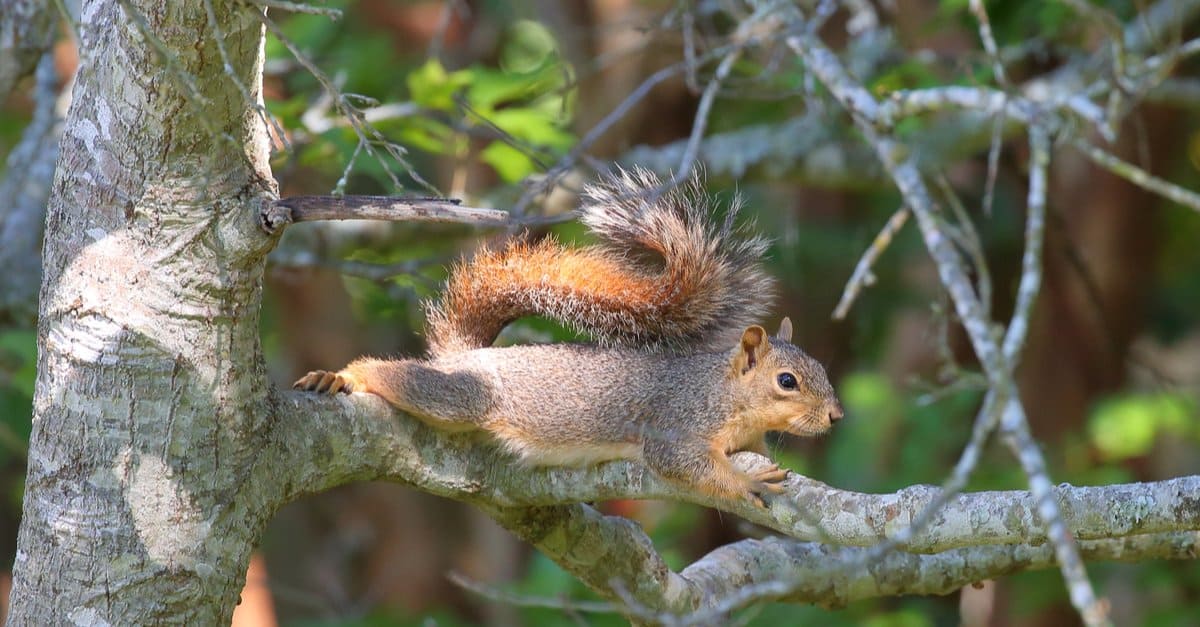
The fox
squirrel
is the largest tree squirrel in North America.
©JustPixs/Shutterstock.com
If you live outside of Australia, a squirrel is a good guess if you see an animal with a bushy tail. There are 200-300 million squirrels in the world, broken down into more than 200 different species. In North America alone, there are over 65 different species of squirrel.
The bushy tail of the eastern gray squirrel is a regular sight in North America, where it is one of the most common squirrels. These squirrels puff out their already-bushy tails when facing a potential predator or when trying to attract a mate. After all, the tail is a squirrel’s most attractive feature—at least to other squirrels! When it comes to practicality, these beautiful tails serve several purposes. When a squirrel is climbing or jumping, their tail helps stabilize them. They also use their tails to communicate with other squirrels and warn of danger. Additionally, mother squirrels use the fur from their tails to line their nests during baby season.
14. Raccoon

Raccoons are opportunistic eaters and will raid trash cans for food.
©kingma photos/Shutterstock.com
The well-known raccoon (or trash panda, casually) is another animal with an impressively fluffy tail. The raccoon’s tail has five to seven distinctive dark rings around it, with a dark tip. These rings help with the raccoon’s overall camouflage, allowing them to blend into their surroundings in the dark. Since these animals are primarily nocturnal, this patterning helps them hide from predators.
The stripes on a raccoon’s tail also serve as a visual guide for baby raccoons. The striped pattern is a cue for the babies, so they don’t lose sight of their mother. With over 10 million raccoons estimated in North America (and maybe as many as 20 million), the raccoon’s tail is a common sight across the country.
13. Fox
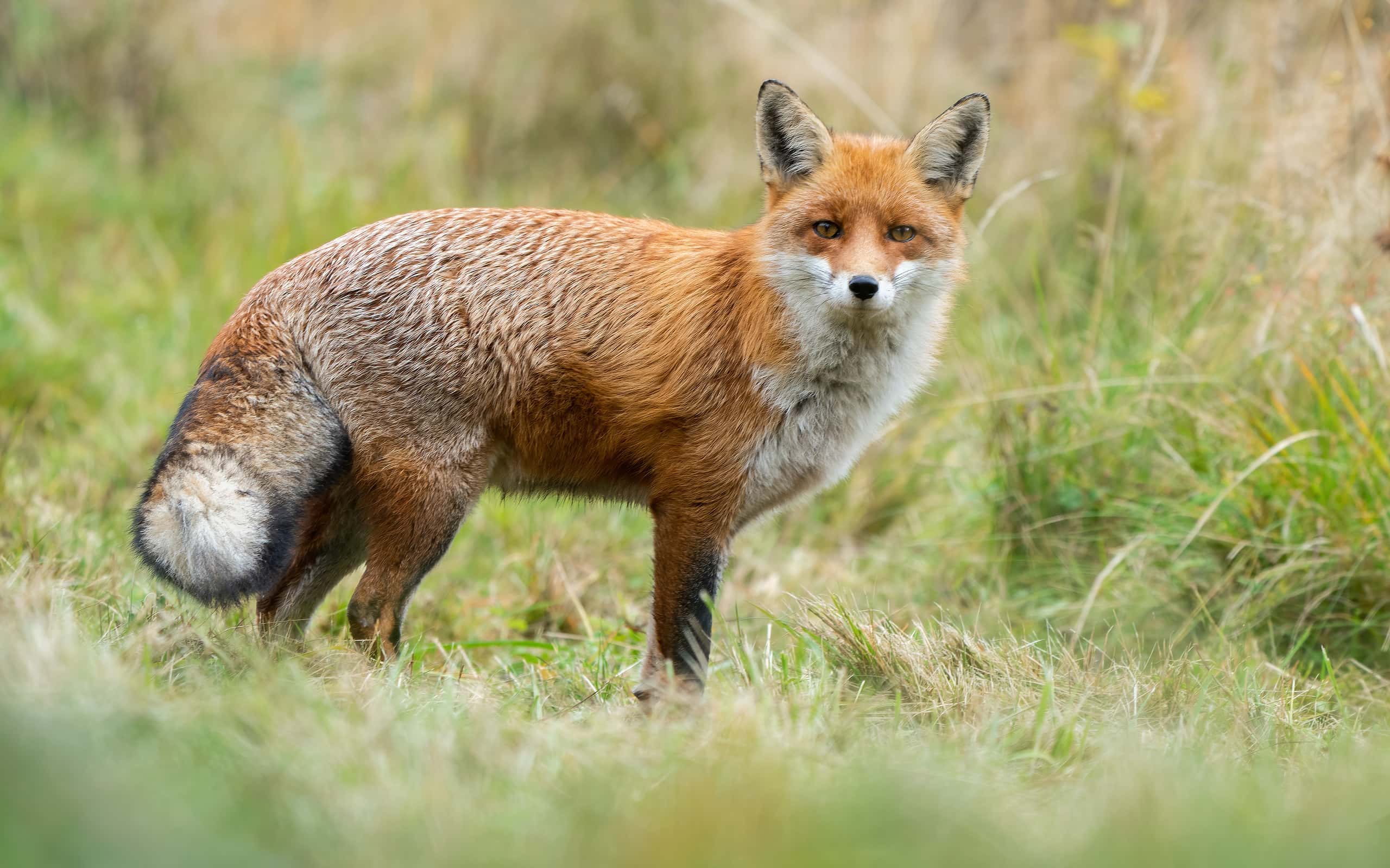
Red foxes are shy animals that prefer to stay away from people.
©JMrocek/ via Getty Images
Many animals use their tails for balance, and the fox is no exception. Several species of fox have big bushy tails (called a “brush”), including the red, arctic, silver, Fennec, cape, and Blanford’s foxes. In addition to helping with balance, a fox’s tail is used to communicate with other foxes. They raise their tails to signal nearby danger or to indicate found food. A fox also uses its tail as a blanket when it is cold, wrapping it around its body for warmth.
There are 12 species of “true foxes” in the genus Vulpes, and fox species are found on every continent except Antarctica. The red fox is the most widely distributed fox (and the most widespread carnivore in the world!) and can be found across the Northern Hemisphere. While the red fox is common across the world, some of the 37 subspecies are critically endangered, including the Sierra Nevada red fox. There are only 18-39 of these foxes remaining in the wild.
12. Lemur

Ring-tailed lemurs are native to Madagascar.
©Marcin Mierzejewski/Shutterstock.com
Although there are 107 species of lemur in the world, perhaps the most distinctive is the ring-tailed lemur. Named for its long, dramatic, black-and-white-ringed tail, this animal’s tail is longer than its body (which averages 15-18 inches long), with a length of around 2 feet. While a lemur’s tail is used for balance, it is not prehensile like a monkey’s and cannot grip. Each tail has 13 alternating black and white rings.
Lemurs are group animals, and their tails help them keep their families together. When lemurs are out foraging, they raise their distinctive tails and hold them high so that other group members can see them. The tail also serves as a warning flag, which they wave if they encounter other groups of lemurs. Sadly, ring-tailed lemur numbers are decreasing due to habitat loss and population fragmentation, and they are one of the 103 lemur species listed as endangered.
11. Tayra
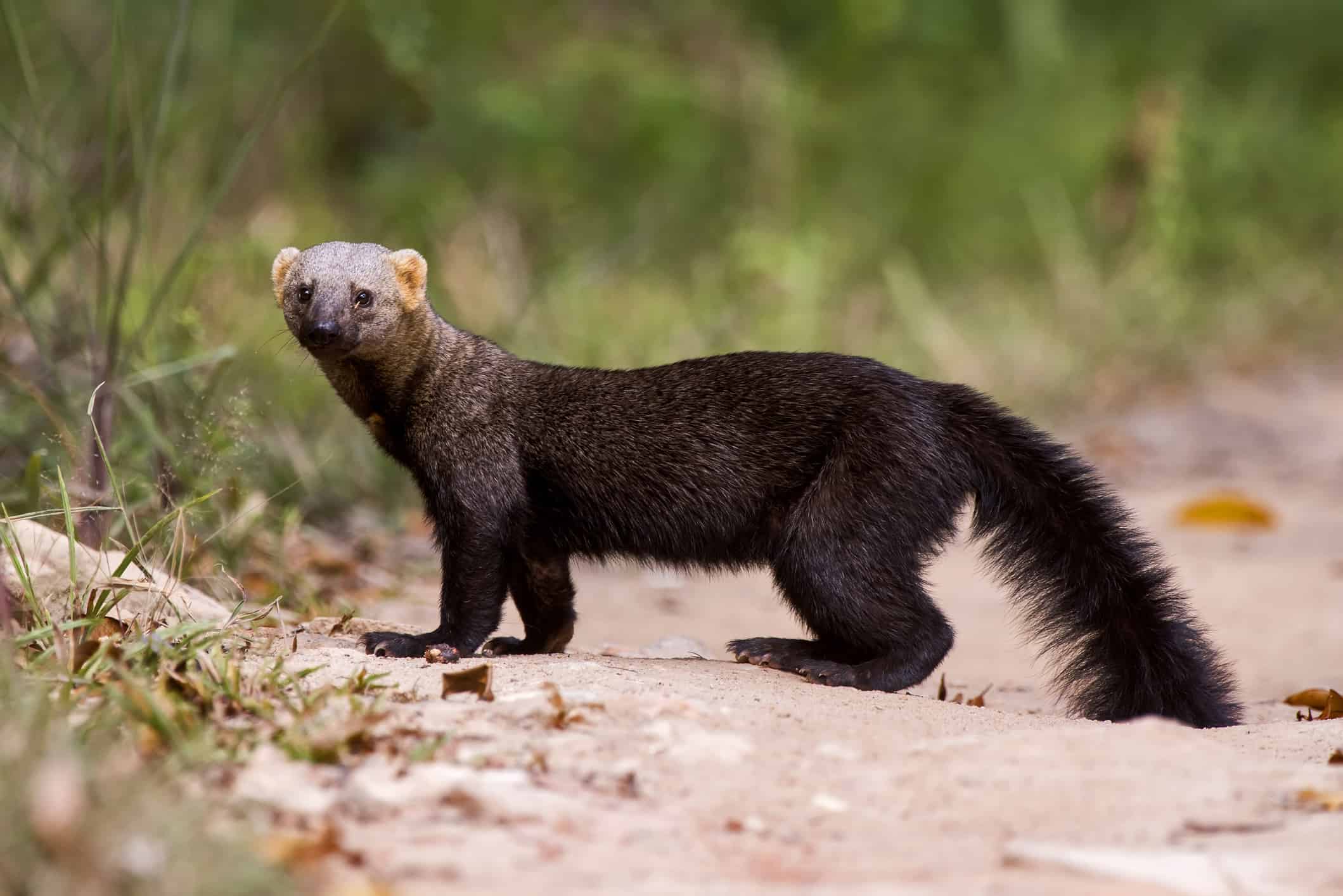
Tayra’s tails can be 1.5 feet long.
©LeoMercon/iStock via Getty Images
The tayra is a member of the weasel family that has long claws for climbing and a bushy tail that helps them counterbalance as they move swiftly through treetops. Also called the bush dog, tayras are found in the neo-tropical forests of Central and South America. Their tails can measure 15-18.5 inches, bringing their total body length to 3-4 feet.
Tayras do much of their foraging in treetops. While they are adept climbers, they look a bit foolish when on the ground. Tayras are particular about what they eat and have been known to pick unripe plantains and hide them until they ripen to their liking.
10. Bushy-Tailed Mongoose
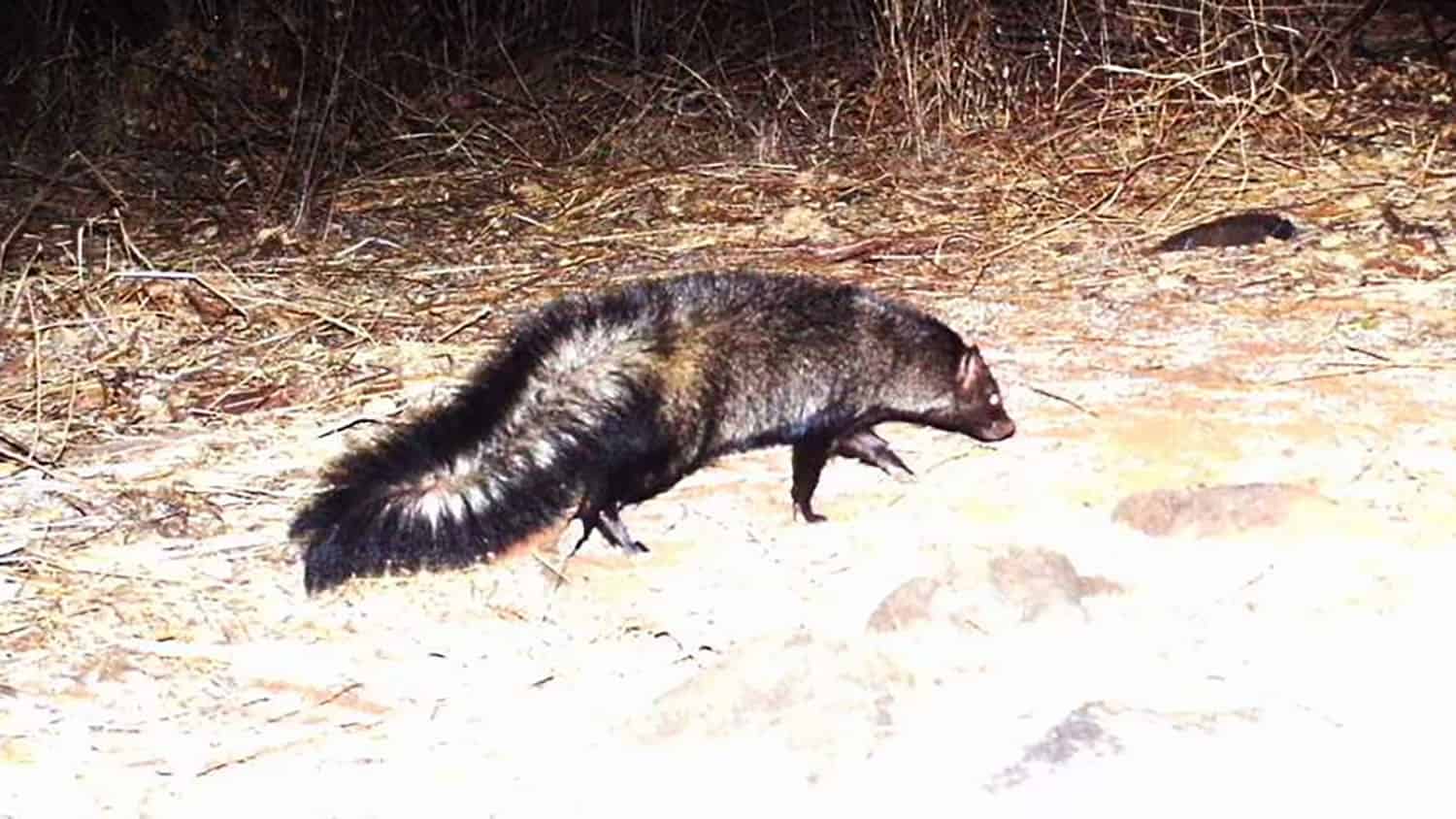
An elusive animal, the bushy-tailed
mongoose
is rarely seen.
©Snapshot Safari - HCO Scoutguard trail camera / CC BY-SA - License
The bushy-tailed mongoose is found in central Africa. These animals have a wide puffy tail that measures more than half of their head-to-body length. Because of the bushy-tailed mongoose’s secretive nature and small size, not much is known about their range or habits. They frequent different habitats such as forests and savannahs that are near riverbeds, where they prey on crabs, rodents, ants, and termites.
9. Striped Skunk

Striped skunks are the most common skunk in North America.
©yhelfman/Shutterstock.com
Odor may be the first thing you think of when spotting a striped skunk, but their tails are also noteworthy! Found across all of North America and into northern Mexico, the striped skunk lives in a variety of habitats from woods and mountains to suburban backyards. The skunk’s distinctive white and black coloring warns predators: Approach only if you dare!
Although many people are afraid of the skunk’s spray, these little animals only release their spray when absolutely necessary. A skunk’s spray is its only defense mechanism, as they do not have claws designed for fighting and are not very fast. If a skunk sprays, it can take seven to 10 days to replenish the smelly oils, leaving them defenseless for the duration.
8. Binturong

Binturongs are also known as bearcats.
©Azahara Falcon/iStock via Getty Images
Also known as a bearcat, the binturong’s little face looks like a cross between a feline and a bear! Native to south and southeast Asia, the binturong has puffy black fur, prominent white whiskers, and a long prehensile bushy tail. Highly intelligent, these animals mimic the actions of people and other animals and are capable of remembering individuals.
Interestingly, the binturong smells good! Many people compare the aroma of a binturong to buttered popcorn. These animals spread their scent through urination, soaking their feet and tails in it to spread the smell. Researchers discovered that this urine contains the same molecules that give cooked popcorn its smell!
7. Maned Wolf
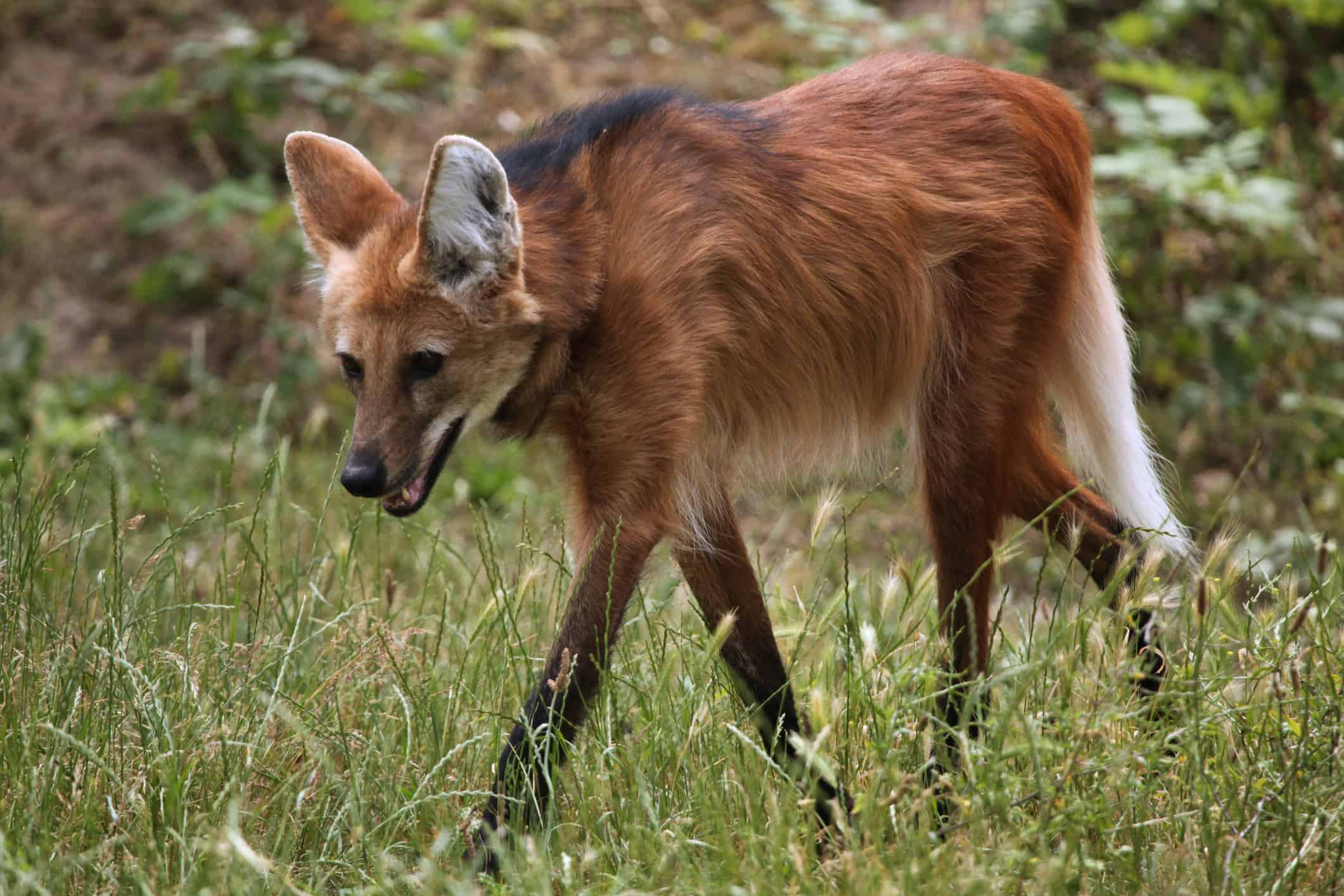
Maned wolves are not actually wolves.
©wrangel/iStock via Getty Images
If you took away its long legs and trademark erectile mane, the maned wolf would easily resemble the red fox. But despite its appearance—and its name—the maned wolf is not related to the fox or the wolf but is the only species in its genus Chrysocyon. Compared to the red fox, which stands about 16 inches at the shoulder, the maned wolf is 3 feet at the shoulder and weighs up to 50 pounds.
These animals with a bushy tail mark their territory with strong-smelling urine that many people liken to the odor of a skunk. Maned wolves live in monogamous pairs that share territories as large as 10 square miles.
6. Ringtail

The ringtail is completely nocturnal.
©lorentrager/iStock via Getty Images
Related to its ring-tailed cousin the raccoon, the ringtail is native to the rocky, arid regions of the American Southwest. These small nocturnal creatures have large eyes, distinctive ringed tails, and oversized ears. Ringtails are excellent climbers and their bushy tails come in handy when ascending vertical surfaces such as trees, cliffs, cacti, and walls. Their big eyes and ears also give them exemplary eyesight and hearing. This helps them track down food (such as fruit, small mammals, eggs, lizards, and snakes) and avoid nocturnal predators including coyotes and great horned owls. In 1986, Arizona named the ringtail its official state mammal.
5. Red Panda

Red pandas are native to the Himalayas.
©AB Photographie/Shutterstock.com
While the red panda shares its name with the black-and-white giant panda, it’s actually not a bear at all. Instead, red pandas are members of the Ailuridae family, alongside raccoons, skunks, and weasels. The arboreal red panda lives in high-altitude forests in the Himalayas and spends most of its time high in the treetops. Their semi-retractable claws help them grip branches as they traverse the canopy, while their thick, bushy, red-and-black-striped tails help them balance. Like foxes, they wrap their tails around themselves to stay warm in cold weather.
Red pandas are generally solitary creatures, and their numbers are declining due to habitat destruction and fragmentation. There may only be 5,000-10,000 red pandas left in the wild.
4. Coyote
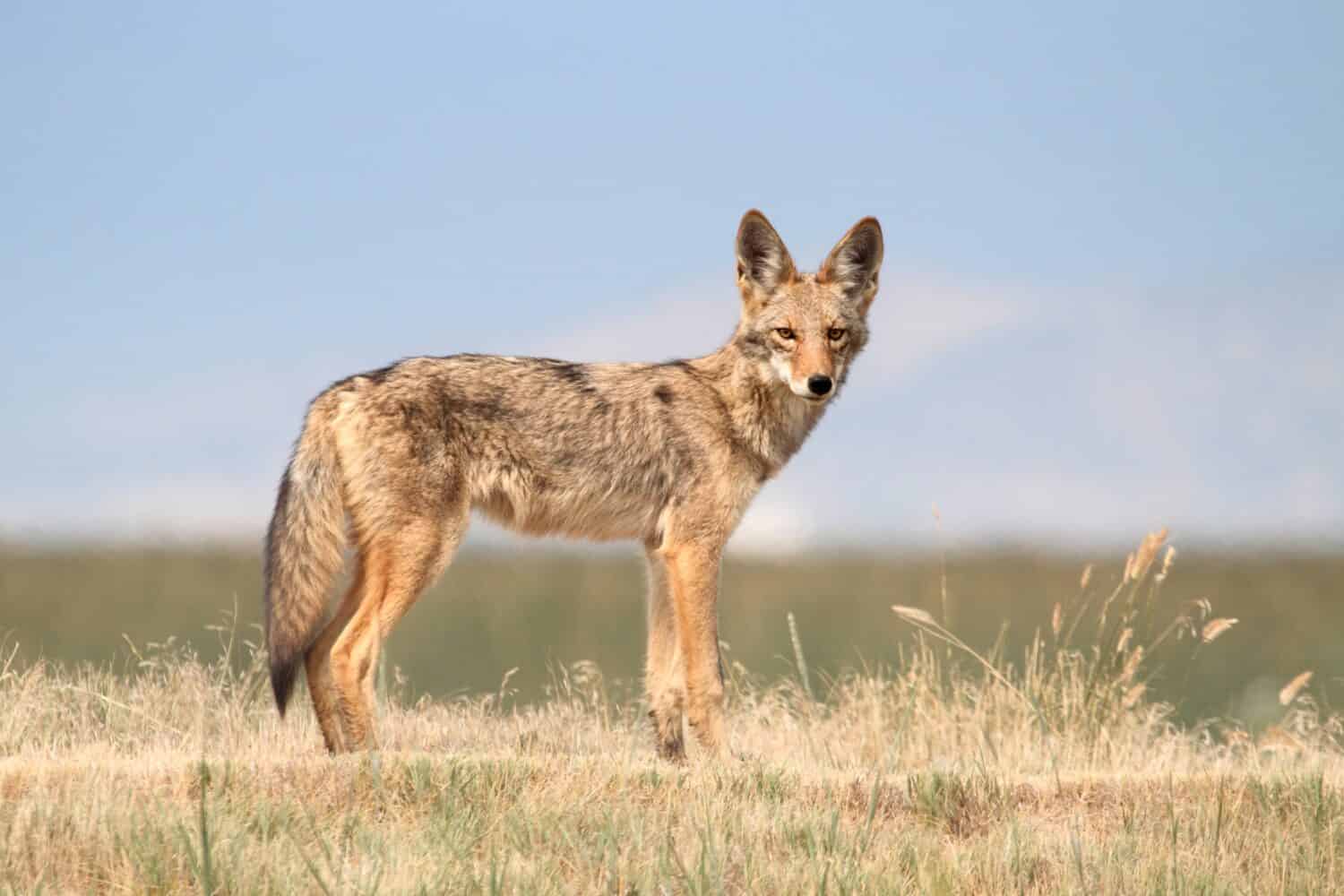
Coyotes live across North and Central America.
©Steve Byland/Shutterstock.com
The misunderstood coyote is often maligned in North America but actually is critical to the ecosystem. These predators eat a variety of small mammals, keeping rodent populations in check. Smaller than wolves, coyotes are reddish-gray animals with bushy tails. While coyotes can live to be 13-15 years old, few make it to this age due to excessive hunting and vehicular accidents.
More than half a million coyotes are intentionally killed by people in the United States every year. However, coyote litter sizes depend on population density and food abundance. In areas where coyotes have been culled and populations have dropped, female coyotes give birth to larger litters to restabilize the population. This renders hunting and killing coyotes ineffective in maintaining populations.
3. Giant Anteater
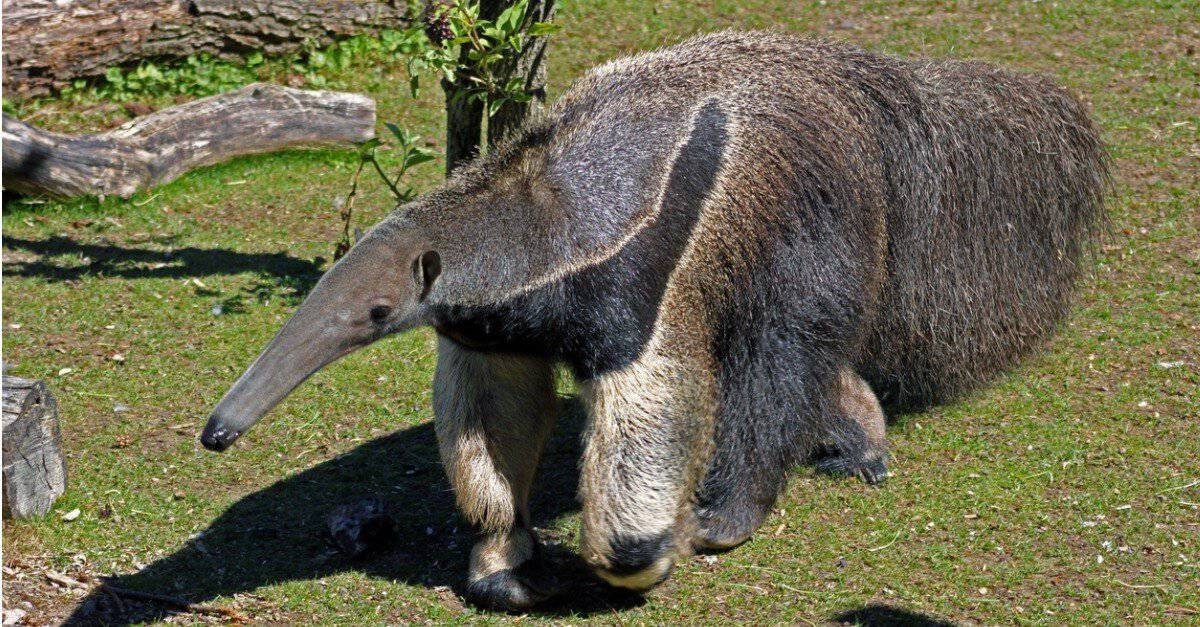
An anteater’s tongue can be up to 2 feet long.
©iStock.com/Ivan Mattioli
The giant anteater may be one of the most peculiar animals on earth. An insectivorous animal found in South and Central America, the anteater subsists on a diet of ants and termites. Giant anteaters use their long claws to dig into ant and termite mounds, and their long noses and sticky tongues to extract the insects.
Perhaps even more remarkable than their long face is their lengthy bushy tail. While their tongues can measure 2 feet long, their tails can reach as long as 3 feet. Giant anteaters use their thick tails for balance when they stand on their hind legs, as well as for cover when sleeping.
2. Chinchilla

Chinchillas live in large groups called herds.
©ATTILA Barsan/Shutterstock.com
While chinchillas have become common pets, they originate from the Andes Mountains in South America. There, the social animals with bushy tails live in groups called herds that can have up to 100 members. They are known for their incredibly soft fur, due to the high number of hairs per follicle. Although humans only have one hair per follicle, chinchillas have 60-90.
Compared to other rodents, the chinchilla’s tail is incredibly strong and long. Chinchillas are excellent jumpers and their tails help balance them while they leap. Chinchillas also use their tails to make themselves look bigger. If they sense a predator, they puff up their tails to intimidate the threat.
1. North American Porcupine

North American porcupines are the second-largest rodent in North America.
©miroslav_1/iStock via Getty Images
The porcupine’s tail isn’t bushy, per se, but it looks bushy! The porcupine’s tail is coated in quills (like the rest of its body), which give it a shaggy appearance. The second-largest rodent in North America, the porcupine uses this spiky, muscular tail for defense. When threatened, the quill-covered creature turns around and swings its 8-10-inch tail at the threat.
While quills coat the top of the tail, the bottom is covered in bristle-like hairs that help with climbing. And these big rodents need all the help they can get when it comes to climbing. While they are commonly found in trees, porcupines are clumsy, lumbering creatures and sometimes fall, quilling themselves in the process. To protect from infection, their quills have evolved to contain antibiotic properties that kick in when the porcupine’s skin is punctured.
Summary of Animals With Bushy Tails
| Number | Animal |
|---|---|
| 1. | North American Porcupine |
| 2. | Chinchilla |
| 3. | Giant Anteater |
| 4. | Coyote |
| 5. | Red Panda |
| 6. | Ringtail |
| 7. | Maned Wolf |
| 8. | Binturong |
| 9. | Striped Skunk |
| 10. | Busky-Tailed Mongoose |
| 11. | Tayra |
| 12. | Lemur |
| 13. | Fox |
| 14. | Raccoon |
| 15. | Squirrel |
The photo featured at the top of this post is © Dmitry Potashkin/iStock via Getty Images
Thank you for reading! Have some feedback for us? Contact the AZ Animals editorial team.






